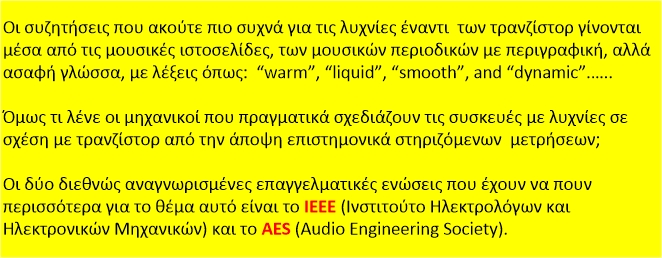- Μηνύματα
- 870
- Reaction score
- 1.204
Vacuum Tubes Versus Solid-State

Κάνω Copy/Paste από εδώ:
The two professional societies that have the most to say on this subject are the IEEE (Institute of Electrical and Electronics Engineers) and the AES(Audio Engineering Society). Both of these professional societies publish peer-reviewed journals, with articles written by engineers and scientists who work in the professional and consumer audio industry, as well as in cutting-edge academic research. If you are seeking a balanced view on this debate, direct yourself to either or both of these societies.Below we point you to some readily available IEEE and AES publications that will help you better understand the differences between solid-state and vacuum tube electronics, their performance, and ultimately their sound.
IEEE - The Cool Sound of Tubes
The IEEE published “The Cool Sound of Tubes” in their August 1998 issue of IEEE Spectrum. In the same article, there is also a useful sidebar on tube versus transistor distortion. Finally, there is a useful table summarizing the advantages and disadvantages of tubes and transistors from both sonic and design points of view. Since the table is only available as a graphic image, we transcribe the text from the summary table below while highlighting some of the key points that directly impact sound quality:
Vacuum tubes – Advantages
- Highly linear without negative feedback, specially some small-signal types
- Clipping is smooth, which is widely considered more musical than transistors
- Tolerant of overloads and voltage spikes
- Characteristics highly independent of temperature, greatly simplifies biasing
- Wider dynamic range than typical transistor circuits, thanks to higher operating voltages
- Device capacitances vary only slightly with signal voltages
- Capacitive coupling can be done with low-value, high-quality film capacitors
- Circuit designs tend to be simpler than semiconductor equivalents
- Operation is usually in Class A or AB, which minimizes crossover distortion
- Output transformer in power amp protects speaker from tube failure
- Maintenance tends to be easier because user can replace tubes
- Bulky, hence less suitable for portable products
- High operating voltages required
- High power consumption, needs heater supply
- Generate lots of waste heat
- Lower power efficiency than transistors in small-signal circuits
- Low-cost glass tubes are physically fragile
- More prone to microphonics than semiconductors, especially in low-level stages
- Cathode electron-emitting materials are used up in operation, resulting in shorter lifetimes (typically 1-5 years for power tubes)
- High-impedance devices that usually need a matching transformer for low impedance loads, like speakers
- Usually higher cost than equivalent transistors
- Usually lower cost than tubes, especially in small-signal circuits
- Smaller than equivalent tubes
- Can be combined in one die to make integrated circuit
- Lower power consumption than equivalent tubes, especially in small-signal circuits
- Less waste heat than equivalent tubes
- Can operate on low-voltage supplies, greater safety, lower component costs, smaller clearances
- Matching transformers not required for low-impedance loads
- Usually more physical ruggedness than tubes (depends on chassis construction)
- Tendency toward higher distortion than equivalent tubes
- Complex circuits and considerable negative feedback required for low distortion
- Sharp clipping, in a manner widely considered non-musical, due to considerable negative feedback commonly used
- Device capacitances tend to vary with applied voltages
- Large unit-to-unit variations in key parameters, such as gain and threshold voltage
- Stored-charge effects add signal delay, which complicates high-frequency and feedback amplifier design
- Device parameters vary considerably with temperature, complicating biasing and raising the possibility of thermal runaway
- Cooling is less efficient than with tubes, because lower operating temperature is required for reliability
- Power MOSFETs have high input capacitances that very with voltage
- Class B totem-pole circuits are common, which can result in crossover distortion
- Less tolerant of overloads and voltage spikes than tubes
- Nearly all transistor power amplifiers have directly-coupled outputs and can damage speakers, even with active protection
- Capacitive coupling usually requires high-value electrolytic capacitors, which give inferior performance at audio-frequency extremes
- Greater tendency to pick up radio frequency interference, due to rectification by low-voltage diode junctions or slew-rate effects
- Maintenance more difficult; devices are not easily replaced by user
- Older transistors and ICs often unavailable after 20 years, making replacement difficult or impossible

